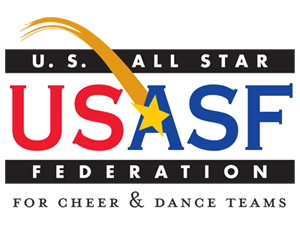U.S. All Star Federation
 | |
| Founded | 2003 |
|---|---|
| Country | United States |
| TV partner(s) | ESPN |
| Official website | www.usasf.net |
The U.S. All Star Federation (USASF) is the governing body for all star cheerleading and dance in the United States. The USASF was founded in December 2003 by cheerleading competition sponsors National Cheerleaders Association, Universal Cheerleaders Association, Cheersport, and America's Best to develop a standard set of safety rules and competition regulations and conduct the Cheerleading Worlds.[1]
History
The first organization to call themselves all stars and go to competitions were the Q94 Rockers from Richmond, Virginia, founded in 1982 by Hilda McDaniel.[2] All-star teams competing prior to 1987 were placed into the same divisions as teams that represented schools and sports leagues. In 1986 National Cheerleaders Association (NCA) decided to address this situation by creating a separate division for these teams lacking a sponsoring school or athletic association, calling it the 'All-Star Division' and debuting it at their 1987 competitions. As the popularity of these types of teams grew, more and more of them were formed, attending competitions sponsored by many different types of organizations and companies, all using their own set of rules, regulations and divisions. This situation became one of the chief concerns of gym owners. These inconsistencies caused coaches to keep their routines in a constant state of flux, detracting from time that should be utilized to develop skills and provide personal attention to their athletes. More importantly, because the various companies were constantly vying for the competitive edge, safety standards were becoming more and more lax. In some cases, unqualified coaches and inexperienced squads were attempting dangerous stunts as a result of these "expanded" sets of rules.[1]
The USASF was formed in 2003 by various competition companies to act as the national governing body for all star cheerleading. The main objective is to create a standard set of rules for judging that are to be followed by all competitions sanctioned by the Federation. At the same time, cheerleading coaches from all over the country organized themselves for the same rule making purpose, calling themselves the National All Star Cheerleading Coaches Congress (NACCC). In 2005, the NACCC was absorbed by the USASF and became their rule making body.[2] By late 2006, the USASF was ready to expand its reach even further, by facilitating the creation of the International All-Star Federation (IASF), the first international governing body for cheerleading. In 2008 a decision was made to begin a biannual process, making the 2009/10 season and the 2010/11 season the first two-year rules cycle.[3] The rules system has helped to democratically regulate the levels (1 through 6) in all star cheerleading.
The Cheerleading Championship

The foremost competition for All Star Cheer is the annual World Cheerleading Championships, also known as Cheerleading Worlds, held at the ESPN Wide World of Sports Complex in Orlando, Fla. The USASF hosted the first Cheerleading Worlds on April 24, 2004. Only senior level 5 and 6 teams can qualify for the event by receiving a bid to attend from one of several qualifying competitions (Youth, Junior, and Senior Restricted level 5 divisions may not receive a bid).[4] In 2007, over 100 teams from 15 different countries competed in the event.[5] In 2009 over 30 countries participated. American teams have won the overwhelming majority of awards.
The Dance Championship
In 2007 the USASF started a new competition called The Dance Championship.
References
- 1 2 "The Cheerleading Worlds Administered by the USASF". Varsity Brands, Inc. Retrieved 2007-09-20.
- 1 2 Smith, Jennifer Renèe (February 2007). "The All-Star Chronicles". American Cheerleader. 13 (1): 40–42. ISSN 1079-9885.
- ↑ Usasf.Net
- ↑ Usasf.net
- ↑ "A World of Cheer!". Archived from the original on 2007-05-11. Retrieved 2007-05-17.